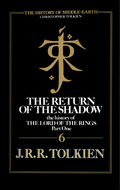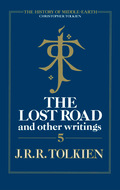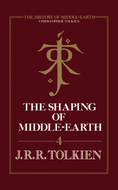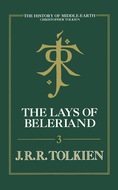Kitap dosya olarak indirilemez ancak uygulamamız üzerinden veya online olarak web sitemizden okunabilir.
Kitabı oku: «The Return of the Shadow»



J. R. R. TOLKIEN
The Return of the Shadow
The History of
The Lord of the Rings
PART ONE
Christopher Tolkien

COPYRIGHT
HarperCollinsPublishers
1 London Bridge Street
London SEI 9GF
This edition 2015
1
First published in Great Britain by Unwin Hyman 1988
Copyright © The Tolkien Estate Limited and C.R. Tolkien 1988
 ® and ‘Tolkien’® are registered trade marks of The Tolkien Estate Limited
® and ‘Tolkien’® are registered trade marks of The Tolkien Estate Limited
All rights reserved under International and Pan-American Copyright Conventions. By payment of the required fees, you have been granted the non-exclusive, non-transferable right to access and read the text of this e-book on screen. No part of this text may be reproduced, transmitted, down-loaded, decompiled, reverse engineered, or stored in or introduced into any information storage and retrieval system, in any form or by any means, whether electronic or mechanical, now known or hereinafter invented, without the express written permission of HarperCollins.
Source ISBN: 9780261102248
Ebook Edition © DECEMBER 2019 ISBN: 9780007348237
Version: 2019-12-09
Find out more about HarperCollins and the environment at www.harpercollins.co.uk/green
HarperCollinsPublishers has made every reasonable effort to ensure that any picture content and written content in this ebook has been included or removed in accordance with the contractual and technological constraints in operation at the time of publication.
DEDICATION
To
RAYNER UNWIN
EPIGRAPH
I met a lot of things on the way that astonished me. Tom Bombadil I knew already; but I had never been to Bree. Strider sitting in the corner at the inn was a shock, and I had no more idea who he was than had Frodo. The Mines of Moria had been a mere name; and of Lothlórien no word had reached my mortal ears till I came there. Far away I knew there were the Horselords on the confines of an ancient Kingdom of Men, but Fangorn Forest was an unforeseen adventure. I had never heard of the House of Eorl nor of the Stewards of Gondor. Most disquieting of all, Saruman had never been revealed to me, and I was as mystified as Frodo at Gandalf’s failure to appear on September 22.
J. R. R. Tolkien, in a letter to
W. H. Auden, 7 June 1955
CONTENTS
Cover
Title Page
Copyright
Dedication
Epigraph
Note on Accessibility
Illustrations
Foreword
THE FIRST PHASE
I A LONG-EXPECTED PARTY
II FROM HOBBITON TO THE WOODY END
III OF GOLLUM AND THE RING
IV TO MAGGOT’S FARM AND BUCKLAND
V THE OLD FOREST AND THE WITHYWINDLE
VI TOM BOMBADIL
VII THE BARROW-WIGHT
VIII ARRIVAL AT BREE
IX TROTTER AND THE JOURNEY TO WEATHERTOP
X THE ATTACK ON WEATHERTOP
XI FROM WEATHERTOP TO THE FORD
XII AT RIVENDELL
XIII ‘QUERIES AND ALTERATIONS’
THE SECOND PHASE
XIV RETURN TO HOBBITON
XV ANCIENT HISTORY
XVI DELAYS ARE DANGEROUS
XVII A SHORT CUT TO MUSHROOMS
XVIII AGAIN FROM BUCKLAND TO THE WITHYWINDLE
THE THIRD PHASE
XIX THE THIRD PHASE (1): THE JOURNEY TO BREE
XX THE THIRD PHASE (2): AT THE SIGN OF THE PRANCING PONY
XXI THE THIRD PHASE (3): TO WEATHERTOP AND RIVENDELL
XXII NEW UNCERTAINTIES AND NEW PROJECTIONS
THE STORY CONTINUED
XXIII IN THE HOUSE OF ELROND
XXIV THE RING GOES SOUTH
XXV THE MINES OF MORIA
Searchable Terms
Other books by J.R.R. Tolkien
About the Publisher
NOTE ON ACCESSIBILITY
The page numbers in this text relate to the printed version of the book; they do not match the pages of your ebook. Due to the high number of references to specific lines of text in the translation, these line numbers, together with their accompanying lines of text, have been fixed in position so that the correct words remain anchored to the correct line number; the text of the translation will therefore not reflow in the same way as the rest of the ebook. After a hyperlink has been activated we recommend using your device’s “Back” button to return to the original location. Where no hyperlink is present you can use your ebook reader’s search tool to find a specific word or passage.
All of the special characters below appear in this ebook. If your e-reader is not displaying these characters you may find this affects your reading enjoyment of the ebook.
| Text | Character |
 | î |
 | û |
 | ó |
 | â |
 | ú |
ILLUSTRATIONS
Map of the Shire
The original opening page of The Lord of the Rings
The original description of the writing on the Ring
The Ring-verse, and the emergence of the Ruling Ring in the narrative
Plan of Bree
The emergence of Treebeard
The earliest map of the lands south of the Map of Wilderland in The Hobbit
The inscription of the West Gate of Moria
FOREWORD
As is well known, the manuscripts and typescripts of The Lord of the Rings were sold by J. R. R. Tolkien to Marquette University, Milwaukee, a few years after its publication, together with those of The Hobbit and Farmer Giles of Ham, and also Mr. Bliss. A long time elapsed between the shipment of these latter papers, which reached Marquette in July 1957, and that of The Lord of the Rings, which did not arrive until the following year. The reason for this was that my father had undertaken to sort, annotate, and date the multifarious manuscripts of The Lord of the Rings, but found it impossible at that time to do the work required. It is clear that he never did so, and in the end let the papers go just as they were; it was noted when they reached Marquette that they were ‘in no order’. Had he done so, he must have seen at that time that, very large though the manuscript collection was, it was nonetheless incomplete.
Seven years later, in 1965, when he was working on the revision of The Lord of the Rings, he wrote to the Director of Libraries at Marquette, asking if a certain scheme of dates and events in the narrative was to be found there, since he had ‘never made out any full schedule or note of the papers transferred to you.’ In this letter he explained that the transfer had taken place at a time when his papers were dispersed between his house in Headington (Oxford) and his rooms in Merton College; and he also said that he now found himself still in possession of ‘written matter’ that ‘should belong to you’: when he had finished the revision of The Lord of the Rings he would look into the question. But he did not do so.
These papers passed to me on his death eight years later; but though Humphrey Carpenter made reference to them in his Biography (1977) and cited from them some early notes, I neglected them for many years, being absorbed in the long work of tracing the evolution of the narratives of the Elder Days, the legends of Beleriand and Valinor. The publication of Volume III of ‘The History of Middle-earth’ was already approaching before I had any idea that the ‘History’ might extend to an account of the writing of The Lord of the Rings. During the last three years, however, I have been engaged at intervals in the decipherment and analysis of The Lord of the Rings manuscripts in my possession (a task still far from completed). It has emerged from this that the papers left behind in 1958 consist largely of the earliest phases of composition, although in some cases (and most notably in the first chapter, which was rewritten many times over) successive versions found among these papers bring the narrative to an advanced state. In general, however, it was only the initial notes and earliest drafts, with outlines for the further course of the story, that remained in England when the great bulk of the papers went to Marquette.
I do not of course know how it came about that these particular manuscripts came to be left out of the consignment to Marquette; but I think that an explanation in general terms can be found readily enough. Immensely prolific as my father was (‘I found not being able to use a pen or pencil as defeating as the loss of her beak would be to a hen,’ he wrote to Stanley Unwin in 1963, when suffering from an ailment in his right arm), constantly revising, re-using, beginning again, but never throwing any of his writing away, his papers became inextricably complex, disorganised, and dispersed. It does not seem likely that at the time of the transfer to Marquette he would have been greatly concerned with or have had any precise recollection of the early drafts, some of them supplanted and overtaken as much as twenty years before; and no doubt they had long since been set aside, forgotten, and buried.
However this may be, it is self-evidently desirable that the separated manuscripts should be joined together again, and the whole corpus preserved in one place. This must have been my father’s intention at the time of the original sale; and accordingly the manuscripts at present in my keeping will be handed over to Marquette University.
The greater part of the material cited or described in this book is found in the papers that remained behind; but the third section of the book (called ‘The Third Phase’) constituted a difficult problem, because in this case the manuscripts were divided. Most of the chapters in this ‘phase’ of composition went to Marquette in 1958, but substantial parts of several of them did not. These parts had become separated because my father had rejected them, while using the remainder as constituent elements in new versions. The interpretation of this part of the history would have been altogether impossible without very full co-operation from Marquette, and this I have abundantly received. Above all, Mr Taum Santoski has engaged with great skill and care in a complex operation in which we have exchanged over many months annotated copies of the texts; and it has been possible in this way to determine the textual history, and to reconstruct the original manuscripts which my father himself dismembered nearly half a century ago. I record with pleasure and deep appreciation the generous assistance that I have received from him, and also from Mr Charles B. Elston, the Archivist of the Memorial Library at Marquette, from Mr John D. Rateliff, and from Miss Tracy Muench.
This attempt to give an account of the first stages in the writing of The Lord of the Rings has been beset by other difficulties than the fact of the manuscripts being widely sundered; difficulties primarily in the interpretation of the sequence of writing, but also in the presentation of the results in a printed book.
Briefly, the writing proceeded in a series of ‘waves’ or (as I have called them in this book) ‘phases’. The first chapter was itself reconstituted three times before the hobbits ever left Hobbiton, but the story then went all the way to Rivendell before the impulse failed. My father then started again from the beginning (the ‘second phase’), and then again (the ‘third phase’); and as new narrative elements and new names and relations among the characters appeared they were written into previous drafts, at different times. Parts of a text were taken out and used elsewhere. Alternative versions were incorporated into the same manuscript, so that the story could be read in more than one way according to the directions given. To determine the sequence of these exceedingly complex movements with demonstrable correctness at all points is scarcely possible. One or two dates that my father wrote in are insufficient to give more than very limited assistance, and references to the progress of the work in his letters are unclear and hard to interpret. Differences of script can be very misleading. Thus the determination of the history of composition has to be based very largely on clues afforded by the evolution of names and motives in the narrative itself; but in this there is every possibility of going astray through mistaking the relative dates of additions and alterations. Exemplification of these problems will be found throughout the book. I do not suppose for one moment that I have succeeded in determining the history correctly at every point: indeed there remain several cases where the evidence appears to be contradictory and I can offer no solution. The nature of the manuscripts is such that they will probably always admit of differing interpretations. But the sequence of composition that I propose, after much experimentation with alternative theories, seems to me to fit the evidence very much the best.
The earliest plot-outlines and narrative drafts are often barely legible, and become more difficult as the work proceeded. Using any scrap of the wretched paper of the war years that came to hand – sometimes writing not merely on the backs of examination scripts but across the scripts themselves – my father would dash down elliptically his thoughts for the story to come, and his first formulations of narrative, at tearing speed. In the handwriting that he used for rapid drafts and sketches, not intended to endure long before he turned to them again and gave them a more workable form, letters are so loosely formed that a word which cannot be deduced or guessed at from the context or from later versions can prove perfectly opaque after long examination; and if, as he often did, he used a soft pencil much has now become blurred and faint. This must be borne in mind throughout: the earliest drafts were put urgently to paper just as the first words came to mind and before the thought dissolved, whereas the printed text (apart from a sprinkling of dots and queries in the face of illegibility) inevitably conveys an air of calm and ordered composition, the phrasing weighed and intended.
Turning to the way in which the material is presented in this book, the most intractable problem lies in the development of the story through successive drafts, always changing but always closely dependent on what preceded. In the rather extreme case of the opening chapter ‘A Long-expected Party’, there are in this book six main texts to be considered and a number of abandoned openings. A complete presentation of all the material for this one chapter would almost constitute a book in itself, not to speak of a mass of repetition or near-repetition. On the other hand, a succession of texts reduced to extracts and short citations (where the versions differ significantly from their predecessors) is not easy to follow, and if the development is traced at all closely this method also takes up much space. There is no really satisfactory solution to this. The editor must take responsibility for selecting and emphasizing those elements that he considers most interesting and most significant. In general I give the earliest narrative complete, or nearly complete, in each chapter, as the basis to which subsequent development can be referred. Different treatment of the manuscripts calls for different arrangement of the editorial element: where texts are given more or less in full much use is made of numbered notes (which may constitute an important part of the presentation of a complex text), but where they are not the chapter proceeds rather as a discussion with citations.
My father bestowed immense pains on the creation of The Lord of the Rings, and my intention has been that this record of his first years of work on it should reflect those pains. The first part of the story, before the Ring left Rivendell, took by far the most labour to achieve (hence the length of this book in relation to the whole story); and the doubts, indecisions, unpickings, restructurings, and false starts have been described. The result is necessarily extremely intricate; but whereas it would be possible to recount the history in a greatly reduced and abbreviated form, I am convinced that to omit difficult detail or to oversimplify problems and explanations would rob the study of its essential interest.
My object has been to give an account of the writing of The Lord of the Rings, to exhibit the subtle process of change that could transform the significance of events and the identity of persons while preserving those scenes and the words that were spoken from the earliest drafts. I therefore (for example) pursue in detail the history of the two hobbits who ultimately issued in Peregrin Took and Fredegar Bolger, but only after the most extraordinary permutations and coalescences of name, character, and rôle; on the other hand I refrain from all discussion that is not directly relevant to the evolution of the narrative.
In the nature of the book, I assume conversance with The Fellowship of the Ring, and comparison is made throughout of course with the published work. Page-references to The Fellowship of the Ring (abbreviated FR) are given to the three-volume hardback edition of The Lord of the Rings (LR) published by George Allen and Unwin (now Unwin Hyman) and Houghton Mifflin Company, this being the edition common to both England and America, but I think that it will be found in fact that almost all such references can be readily traced in any edition, since the precise point referred to in the final form of the story is nearly always evident from the context.
In the ‘first phase’ of writing, which took the story to Rivendell, most of the chapters were title-less, and subsequently there was much shifting in the division of the story into chapters, with variation in titles and numbers. I have thought it best therefore to avoid confusion by giving many of my chapters simple descriptive titles, such as ‘From Hobbiton to the Woody End’, indicating the content rather than relating them to the chapter-titles in The Fellowship of the Ring. As a title for the book it seemed suitable to take one of my father’s own suggested but abandoned titles for the first volume of The Lord of the Rings. In a letter to Rayner Unwin of 8 August 1953 (The Letters of J. R. R. Tolkien, no. 139) he proposed The Return of the Shadow.
No account is given in this book of the history of the writing of The Hobbit up to its original publication in 1937, although, from the nature of its relationship to The Lord of the Rings, the published work is constantly referred to. That relationship is curious and complex. My father several times expressed his view of it, but most fully and (as I think) most accurately in the course of a long letter to Christopher Bretherton written in July 1964 (Letters no. 257).
I returned to Oxford in Jan. 1926, and by the time The Hobbit appeared (1937) this ‘matter of the Elder Days’ was in coherent form. The Hobbit was not intended to have anything to do with it. I had the habit while my children were still young of inventing and telling orally, sometimes of writing down, ‘children’s stories’ for their private amusement … The Hobbit was intended to be one of them. It had no necessary connexion with the ‘mythology’, but naturally became attracted towards this dominant construction in my mind, causing the tale to become larger and more heroic as it proceeded. Even so it could really stand quite apart, except for the references (unnecessary, though they give an impression of historical depth) to the Fall of Gondolin, the branches of the Elfkin, and the quarrel of King Thingol, Lúthien’s father, with the Dwarves….
The magic ring was the one obvious thing in The Hobbit that could be connected with my mythology. To be the burden of a large story it had to be of supreme importance. I then linked it with the (originally) quite casual reference to the Necromancer, whose function was hardly more than to provide a reason for Gandalf going away and leaving Bilbo and the Dwarves to fend for themselves, which was necessary for the tale. From The Hobbit are also derived the matter of the Dwarves, Durin their prime ancestor, and Moria; and Elrond. The passage in Ch. iii relating him to the Half-elven of the mythology was a fortunate accident, due to the difficulty of constantly inventing good names for new characters. I gave him the name Elrond casually, but as this came from the mythology (Elros and Elrond the two sons of Eärendel) I made him half-elven. Only in The Lord was he identified with the son of Eärendel, and so the great-grandson of Lúthien and Beren, a great power and a Ringholder.
How my father saw The Hobbit – specifically in relation to ‘The Silmarillion’ – at the time of its publication is shown clearly in the letter that he wrote to G. E. Selby on 14 December 1937:
I don’t much approve of The Hobbit myself, preferring my own mythology (which is just touched on) with its consistent nomenclature – Elrond, Gondolin, and Esgaroth have escaped out of it – and organized history, to this rabble of Eddaic-named dwarves out of Völuspá, newfangled hobbits and gollums (invented in an idle hour) and Anglo-Saxon runes.
The importance of The Hobbit in the history of the evolution of Middle-earth lies then, at this time, in the fact that it was published, and that a sequel to it was demanded. As a result, from the nature of The Lord of the Rings as it evolved, The Hobbit was drawn into Middle-earth – and transformed it; but as it stood in 1937 it was not a part of it. Its significance for Middle-earth lies in what it would do, not in what it was.
Later, The Lord of the Rings in turn reacted upon The Hobbit itself, in published and in (far more extensive) unpublished revisions of the text; but all that lies of course far in the future at the point which this History has reached.
In the manuscripts of The Lord of the Rings there is extreme inconsistency in such matters as the use of capital letters and hyphens, and the separation of elements in compound names. In my representation of the texts I have not imposed any standardization in this respect, though using consistent forms in my own discussions.





